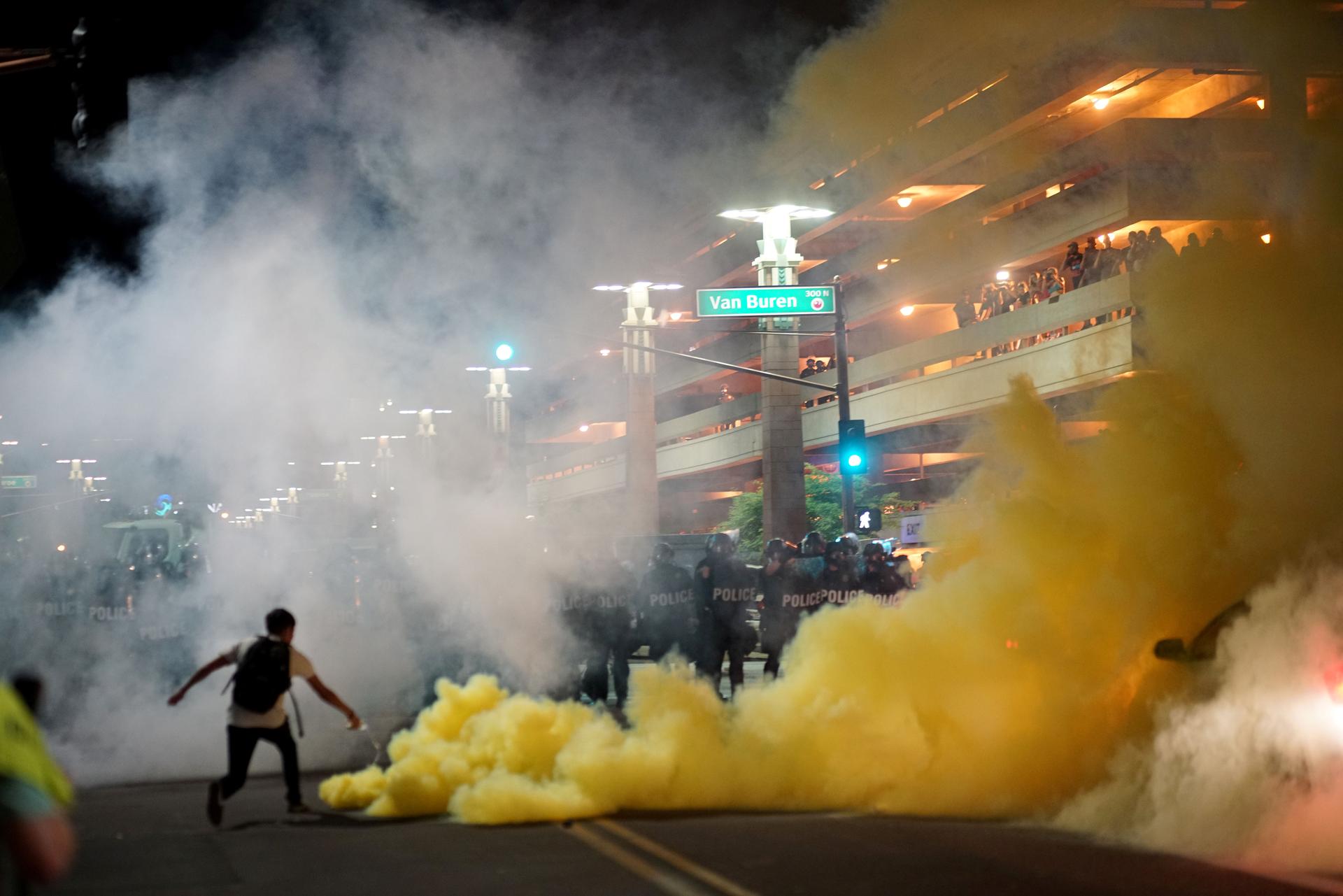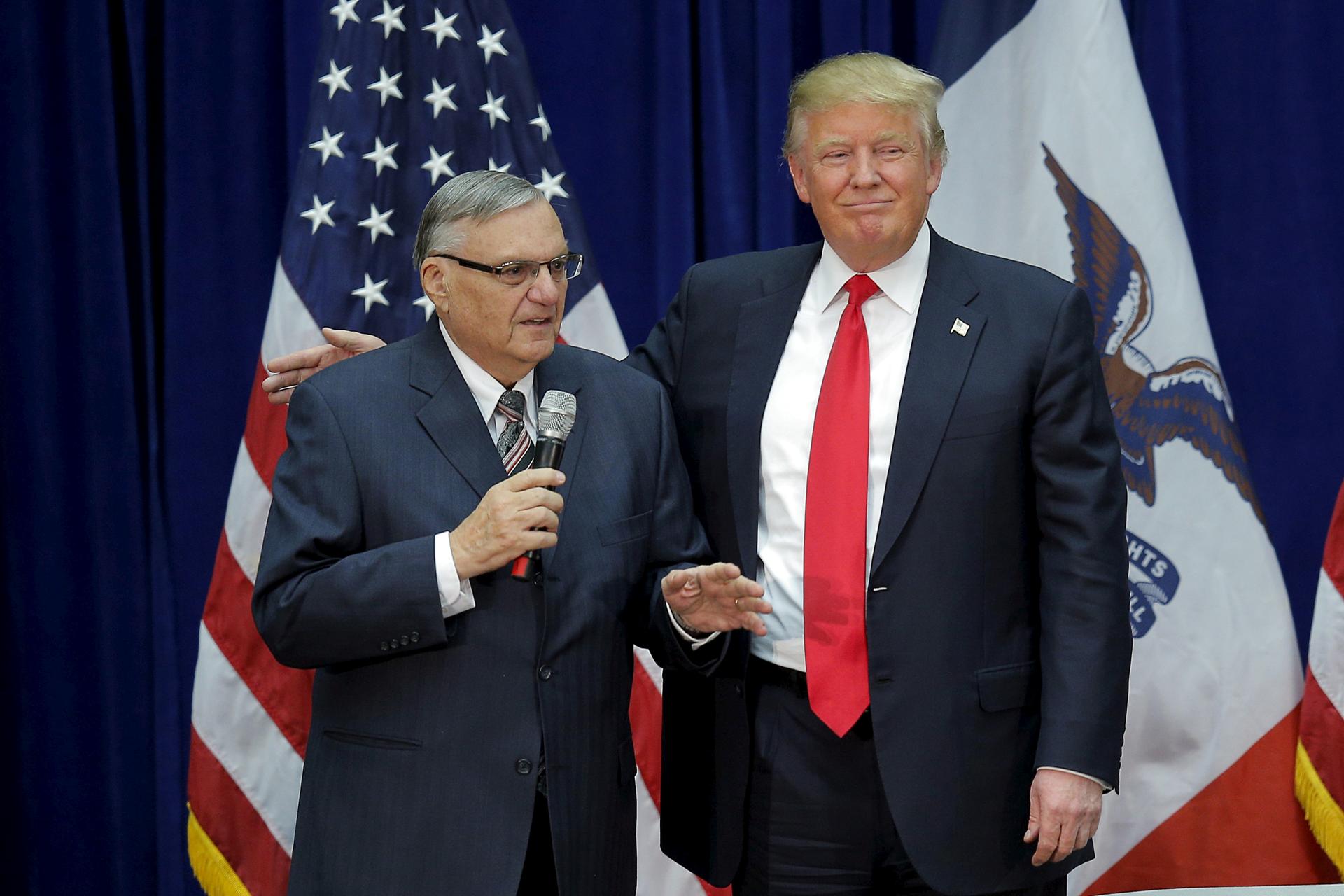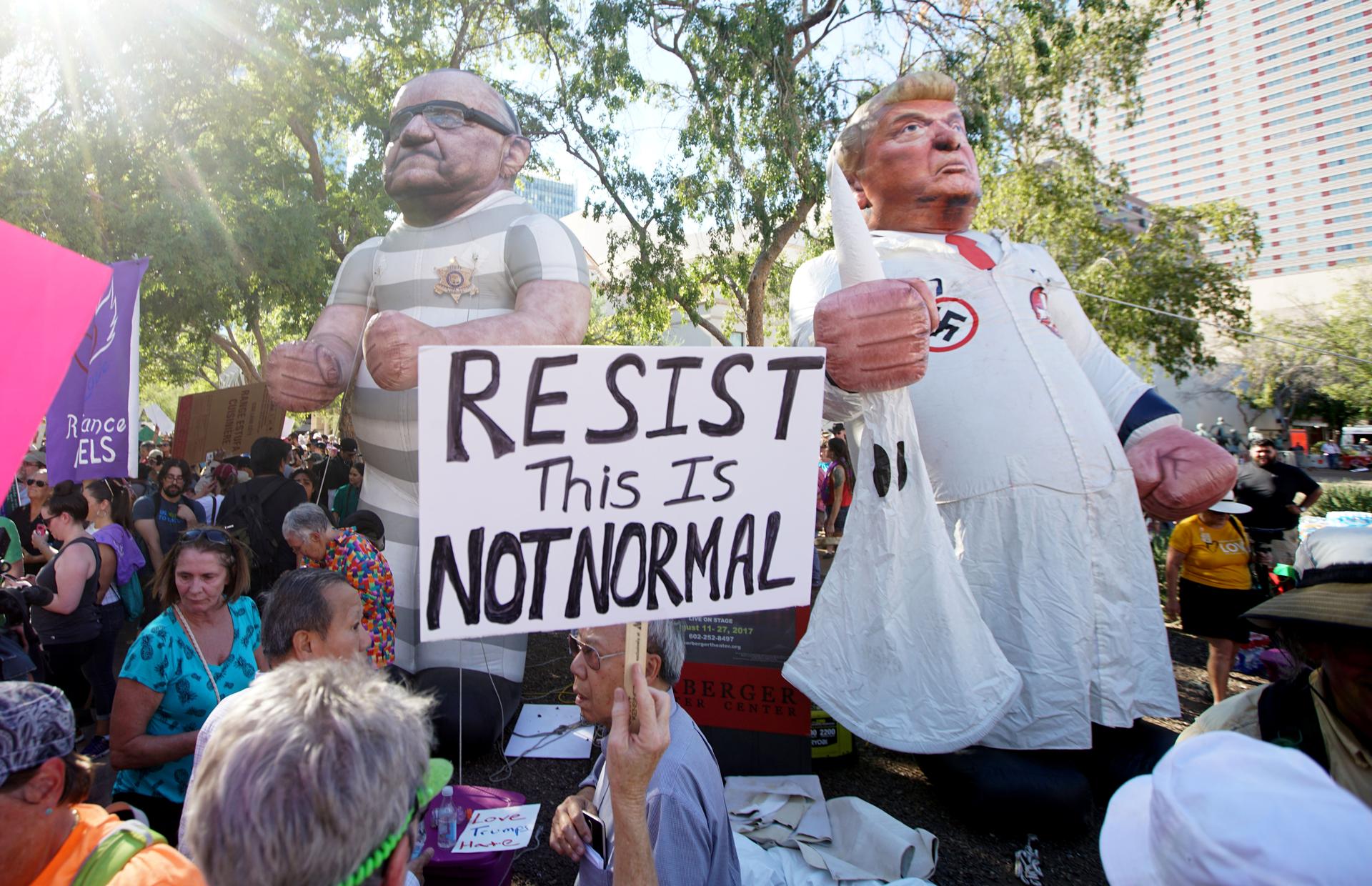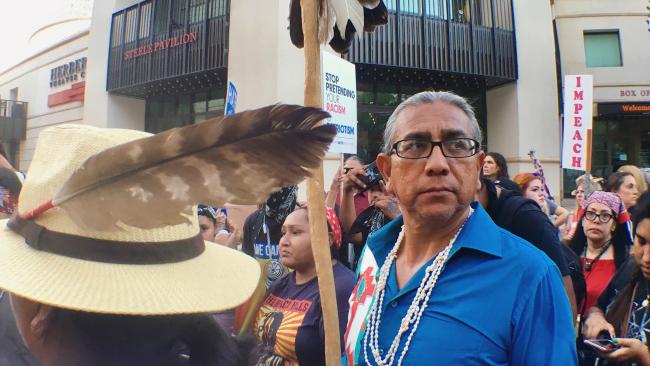‘This is our land’: Indigenous rights activists respond to white supremacist rhetoric
Shannon Rivers protested President Donald Trump at a campaign-style rally in Phoenix on Tuesday. For Rivers, a tribal citizen of the Akimel O’odham of the Gila River Indian Community, the alliance between indigenous people and Latinos is personal. “Many [Latinos] are our family,” he said.
It came with a loud boom followed by a second one — a series of smoke bombs lodged toward a crowd of protesters in downtown Phoenix Tuesday night.
“You guys better get going before the gas starts,” said a local police officer wearing a helmet, his plexiglass face shield flipped upward atop his head.
“Wait … What gas?” said a young cyclist standing nearby. Then he asked again with more urgency. “What gas?!”
Half a city block away, a peaceful gathering had erupted in rapid but short-lived chaos after, police say, someone lodged a burning projectile at an officer, and in response, police fired back. The city’s police chief said pepper balls, tear gas and other nonlethal chemicals were used. The drama disrupted what had otherwise been an hours-long nonviolent demonstration held by many protesting President Donald Trump. He chose Phoenix to host a campaign-style rally, his first event since the deadly clashes in Charlottesville, Virginia.

For the indigenous people who attended the rally, this police response was a familiar narrative.
“The historical trauma is still happening today. We’re still suffering but in different ways,” said Anthony Thosh Collins, a citizen of the Onk Akimel O’odham with the Salt River Pima-Maricopa Indian Community. His tribe’s land base is surrounded by the nearby sprawling suburbs of Scottsdale, Mesa, and Tempe. But for Collins and dozens of other indigenous rights activists protesting Tuesday night, their message in response to recent white supremacist rhetoric was simple: “This is our land.”
“I would hope in the future the mainstream media [start] recognizing us as the original inhabitants of the land and that we too are still suffering today,” Collins said.
'Take back our country'
The voices of indigenous people — and Latinos — have largely been muted in the wake of violence at Charlottesville and now in the aftermath of Trump’s Phoenix rally. Tuesday’s spurt of sudden clashes between police and demonstrators — and to a lesser extent, Trump’s bashing of the media in his speech — dominated the news cycle. The reaction to America’s tension combined with Trump’s shock politics has meant an unsteady focus paid to broader-based issues impacting communities of color.
In the aftermath of recent terror in Charlottesville led by white nationalists, people across America have worked to flip the script on its oppressive narrative by dismantling one Confederate monument after another. The act was seen as one way to denounce racist ideals linked to chattel slavery.
But it took a comedian, Tina Fey, to remind Americans that it’s not only African Americans who have been harmed by white supremacy in this country. Indian Country has been harmed, too.
Americans need to examine the white supremacist creed — to “take back our country” — more closely, Fey pointed out.
“It’s not our country,” said Fey as she “sheetcaked” her way through a taping of Saturday Night Live. “We stole it from the Native Americans.”
oembed://https%3A//www.youtube.com/watch%3Fv%3DiVvpXZxXWZU
The comedian also recalled the peaceful protests at Standing Rock, where Native Americans and their allies were met with extreme use of militarized force. This recognition underscored one of the more lopsided realities today when it comes to policing communities of color in America—a trend familiar to Arizona’s Latino community, as well.
“What we saw yesterday is nothing new,” said Viridiana Hernandez, a Latino rights activist with the Center for Neighborhood Leadership. She was speaking before journalists at a press conference in downtown Phoenix on Wednesday, the morning after police had used nonlethal force to disperse the crowd of anti-Trump protesters.
“It is a continuation of the violent culture of the Phoenix Police Department. This isn’t the first time that we see this, and it will not be the last,” Hernandez said.
'A very volatile thing'
The police response Tuesday night caused Latino activists to amplify their criticism of Trump when he suggested he’d pardon the controversial Arizona Sheriff Joe Arpaio.
“You know what, I’ll make a prediction: I think he’s going to be just fine, OK?” Trump said to a room of cheering supporters, referring to a potential Arpaio pardon. “But I won't do it tonight, because I don’t want to cause any controversy.”
Since 1993, Arpaio served as top cop to Maricopa County, a jurisdiction which also includes patrolling the city limits of Phoenix. Last month he was found convicted of criminal contempt of court — a technicality for his refusal to follow a judge’s order to stop racially profiling and illegally detaining people presumed to have entered the country illegally. Many of the people harassed and even arrested under these policing practices were US citizens or legal residents.
“His case was totally politicized,” said Alan Olsen. The Trump supporter stood outside for more than an hour in 107-degree heat just to hear the president’s speech. He defended Trump’s back-and-forth reactions to Charlottesville and also backed Arpaio. “He was doing a job that no one wanted to do,” Olsen said of the sheriff. “And he would say, ‘I don’t make the laws, I just enforce them.’”
To be sure, there were concerns that an Arpaio pardon declared Tuesday night by Trump could have led to violence among people both for and against it. Hours before the rally, Phoenix Mayor Greg Stanton explained to CNN the impact of a potential pardon, saying, “It would be a very bad thing and potentially a very volatile thing here in Phoenix.”

In Phoenix, Latino rights advocates are not alone in their stand against racial inequality in Arizona’s justice system. On Tuesday night, as some chanted phrases such as “No hate. No fear. Immigrants are welcome here,” a circle of indigenous people mostly from area tribal communities stood, rattling gourds and singing songs that had been passed down from their ancestors.
For organizers like Shannon Rivers, a tribal citizen of the Akimel O’odham of the Gila River Indian Community, the alliance was personal. “This issue with Arpaio, it affects my family intimately,” he said.
Nine years ago, Rivers' brother-in-law, Ysidro “Chilo” Dozel, was picked up in a raid by U.S. Immigration and Customs Enforcement officers. He was sent back to Mexico even though he was a U.S. citizen. This summer, he died never able to resolve his case that would have reunited him with his wife and children and the community where he lived and worked for years.
“But his case is one of thousands, right,” Rivers said. “That’s why for us, as indigenous peoples, we try to bring that reality in peace and kindness and to stand in solidarity with all of these folks, including Latinos, who many are our family.”
Latino rights activists are leading the way for broader reform beyond Arpaio’s sentencing. The former sheriff faces up to six months in jail for his misdemeanor conviction.
“For us it’s not about the pardon,” said Carlos Garcia, an organizer with Puente Movement, a nonprofit organization based in Phoenix. “What we need is the culture and policies of Arpaio to be removed. What we need is the Phoenix police department not to act worse than Arpaio ever did.”
'It’s almost like he wants to separate the country'
Next week, a coalition of advocacy groups will be standing in solidarity when activists plan to attend a Phoenix City Council meeting. There, they intend to make formal complaints about the police department’s tear-gassing of demonstrators.
“We cannot and will not tolerate the disparate violence that the city of Phoenix chose to wage on common people who came to speak out against Donald Trump,” said J.J. Johnson, an organizer with the Phoenix-based Black Lives Matter movement.
Johnson’s reference to Tuesday’s diverse crowd as “common people” is reminiscent of the little-known revival of the Poor People’s Campaign of 1968, a continuation of Martin Luther King Jr.’s plan. The movement intended to alleviate poverty across racial lines had faded following King’s assassination. Fifty years later, Rev. William Barber and a joint force of activists are reviving King’s crusade while addressing modern themes of wealth inequality, systemic racism, and a fair shot at a decent life.

“It’s not about left versus right,” Barber told David Remnick, editor-in-chief of The New Yorker. The interview was taped live before an audience in May and was featured in an episode of the magazine’s podcast. “It’s about right versus wrong,” said Barber, referring to an America he described as having lost its moral compass. “In some ways, if we work together, we’ll change the world.”
“Show up at the city council. That is how we are going to effect change,” Johnson told a crowd of advocates from various social movements. “Get off your couch, push back from the keyboard, and get out and talk to the people who control this police department.”
In the greater view, reversing Arpaio’s police tactics represents but one fight in the greater battle. Tuesday night, Trump also energized his base with more talk of building a multibillion-dollar wall along the border of the US and Mexico. He even threatened a government shutdown if Congress did not approve funding.
“It’s almost like he wants to separate the country,” said Rivers, who encouraged state and local politicians to be next to join the region’s growing coalition of advocates pushing back against Trump. “I hope some of these senators in Arizona and the mayor of Phoenix are standing up and saying no to Trump — saying we will not stand for your bigotry, your racism, and your ideology that’s destructive.”
This story was originally published by YES!, a nonprofit publication that supports people’s active engagement in solving today’s social, political, and environmental challenges.
